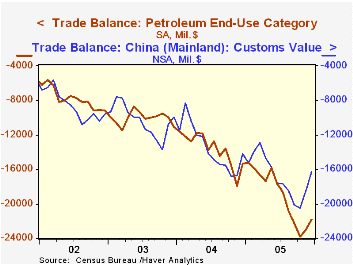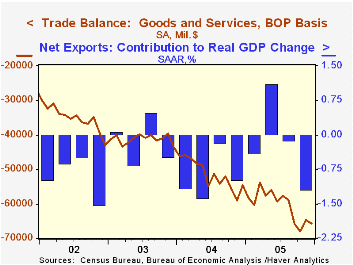 Global| Feb 10 2006
Global| Feb 10 2006U.S. 2005 Trade Deficit Another Record Paced by Oil & China
by:Tom Moeller
|in:Economy in Brief
Summary
At $725.8B the U.S. foreign trade deficit set another record last year, up from the prior record of $617.6B in 2004. The year was capped by a December deficit in goods & services trade of $65.7B versus the November deficit that was [...]

At $725.8B the U.S. foreign trade deficit set another record last year, up from the prior record of $617.6B in 2004. The year was capped by a December deficit in goods & services trade of $65.7B versus the November deficit that was revised slightly deeper from the initial estimate. Consensus expectations had for a $65.0B deficit during December.
The $229.2B petroleum deficit last year was $65.8B deeper than during 2004 and accounted for 62% of the deepening in the 2005 total foreign trade deficit. Crude oil's per barrel price rose to an average $46.90 (36.2%) and the per day volume of all petroleum imports rose 1.7%. In December, crude oil prices averaged $49.76, down from the monthly high of $57.32 during September.
With China the US trade deficit improved for the second consecutive month, to $16.3B, but averaged $201.6B for the full year versus $161.9B in 2004. The $39.7B y/y deepening accounted for another 34% of last year's worsening of the total US trade deficit. The US trade deficit with Japan improved again in December to $6.8B ($82.7B in 2005) as did the monthly trade deficit with the Asian NICs to $1.1B ($15.9B in 2005). The deficit with the European Union also improved $10.1B ($122.4B in 2005) during December.
Imports of nonpetroleum products rose 10.1% during all of last year, capped by a 3.5% rise in December. Imports of nonauto consumer goods rose 5.3% during December, 9.1% for the full year, while December capital goods imports rose 2.5% and 10.5% during 2005. Imports of advanced technology products slipped modestly in December following no change in November (NSA) but rose 9.1% for the full year after a 15.1% rise during 2004.
Total exports rose strongly for the fourth month in the last five and the 2.1% December increase finished a year of 10.4% growth. December's gain was led by a 6.4% (12.1% y/y) jump in exports of nonauto consumer goods and a 4.7% (9.5% y/y) rise in autos. Capital goods rose 0.7% after a 3.8% November surge and pulled the 2005 average up 9.2%. Exports of advanced technology products jumped 7.5% (NSA) during December and 7.0% for the full year.
The Economic Outlook by Michael H. Moskow, President & CEO of the Federal Reserve Bank of Chicago, can be found here.
| Foreign Trade | Dec | Nov | Y/Y | 2005 | 2004 | 2003 |
|---|---|---|---|---|---|---|
| Trade Deficit | $65.7B | $64.7B | $54.7B (12/04) | $725.8B | $617.6B | $494.8B |
| Exports - Goods & Services | 2.1% | 1.8% | 9.6% | 10.4% | 12.6% | 4.6% |
| Imports - Goods & Services | 1.9% | -0.7% | 13.3% | 12.9% | 16.6% | 8.5% |
Tom Moeller
AuthorMore in Author Profile »Prior to joining Haver Analytics in 2000, Mr. Moeller worked as the Economist at Chancellor Capital Management from 1985 to 1999. There, he developed comprehensive economic forecasts and interpreted economic data for equity and fixed income portfolio managers. Also at Chancellor, Mr. Moeller worked as an equity analyst and was responsible for researching and rating companies in the economically sensitive automobile and housing industries for investment in Chancellor’s equity portfolio. Prior to joining Chancellor, Mr. Moeller was an Economist at Citibank from 1979 to 1984. He also analyzed pricing behavior in the metals industry for the Council on Wage and Price Stability in Washington, D.C. In 1999, Mr. Moeller received the award for most accurate forecast from the Forecasters' Club of New York. From 1990 to 1992 he was President of the New York Association for Business Economists. Mr. Moeller earned an M.B.A. in Finance from Fordham University, where he graduated in 1987. He holds a Bachelor of Arts in Economics from George Washington University.






